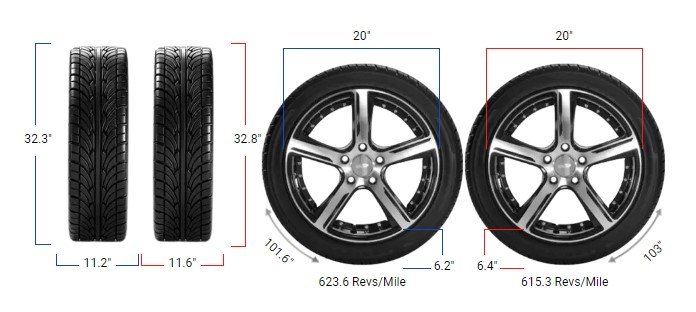Tire Size 285/55r20 vs 295/55r20
 Switching from 285/55r20 to 295/55r20 tires is generally acceptable, with only a 1.3% increase in diameter. This change provides a slightly wider tread and taller sidewall, improving traction and ride comfort. However, the differences are minimal and may not significantly impact performance or handling for most drivers.
Switching from 285/55r20 to 295/55r20 tires is generally acceptable, with only a 1.3% increase in diameter. This change provides a slightly wider tread and taller sidewall, improving traction and ride comfort. However, the differences are minimal and may not significantly impact performance or handling for most drivers.
- Diameter increase of 1.3% falls within the recommended 3% range
- Wider tread by 10mm (0.39 inches) may enhance traction
- Slightly taller sidewall could improve ride comfort
- Minimal impact on speedometer accuracy and fuel efficiency
285/55r20 vs 295/55r20 Table

The primary difference when switching from 285/55r20 to 295/55r20 tires is the increase in width. The new tires are 10mm (0.39 inches) wider, which can provide a slightly larger contact patch with the road.
This additional width may offer improved traction, especially in wet conditions or during cornering. However, the change is relatively small, and many drivers may not notice a significant difference in everyday driving situations.
Fitment Guide
It’s crucial to follow the fitment guide to ensure compatibility and safety. In this case, the diameter difference between 285/55r20 and 295/55r20 tires is only 1.3%, which falls well within the acceptable range of plus or minus 3%.
This means the interchange is recommended and should not cause any major issues with your vehicle’s performance or safety systems. However, it’s always a good idea to double-check your specific vehicle’s specifications and consult with a tire professional if you have any concerns.
On-Road Impact
Switching to 295/55r20 tires will have a minimal impact on your on-road driving experience. Here’s what you might notice:
- Traction: The slightly wider tread (0.39 inches or 10mm) may provide a marginal improvement in traction, especially during cornering or in wet conditions. However, the difference is small enough that many drivers won’t notice a significant change in everyday driving.
- Ride Comfort: The taller sidewall (by 0.22 inches or 5.5mm) could offer a slight improvement in ride comfort, as there’s more rubber to absorb road imperfections. Again, this difference is minimal and may not be noticeable to most drivers.
- Speedometer Accuracy: The 1.3% increase in diameter will cause your speedometer to read slightly lower than your actual speed. For example, when your speedometer shows 20 mph, you’ll actually be traveling at 19.74 mph. This small discrepancy is unlikely to cause any significant issues but is worth being aware of.
- Fuel Efficiency: The larger diameter means fewer revolutions per mile (8.24 fewer), which could theoretically lead to a very slight improvement in fuel efficiency. However, this difference is so small that it’s unlikely to have a measurable impact on your gas mileage.
Off-Road Impact
For those who take their vehicles off-road, the switch to 295/55r20 tires may offer some minor benefits:
- Ground Clearance: The 0.43-inch (11mm) increase in diameter translates to about 0.22 inches (5.5mm) of additional ground clearance. While this is a small change, it could provide a slight advantage when navigating rough terrain or obstacles.
- Traction: The wider tread may offer improved traction in loose surfaces like sand or mud. However, the difference is minimal, and tire tread pattern will likely have a more significant impact on off-road performance than this small width increase.
- Flotation: The slightly larger overall tire size may provide a small improvement in “flotation” on soft surfaces, but the difference is likely to be negligible in most situations.
Aesthetics and Vehicle Appearance
The switch to 295/55r20 tires will result in a subtle change to your vehicle’s appearance:
- Wider Stance: The additional 10mm (0.39 inches) of width may give your vehicle a slightly more aggressive stance, particularly when viewed from the front or rear.
- Filled Wheel Wells: The larger diameter tires will fill out your wheel wells a bit more, which some drivers find aesthetically pleasing.
- Proportions: The change in tire size is small enough that it shouldn’t dramatically alter your vehicle’s overall proportions or look out of place.
Durability and Wear
The difference in size between 285/55r20 and 295/55r20 tires is unlikely to have a significant impact on durability or wear characteristics. However, there are a few minor considerations:
- Contact Patch: The slightly larger contact patch of the 295/55r20 tires may distribute weight more evenly, potentially leading to more even wear. However, this effect would be minimal.
- Sidewall Flex: The taller sidewall of the 295/55r20 tires (by 0.22 inches or 5.5mm) may flex slightly more during cornering, which could theoretically lead to slightly faster wear on the outer edges. In practice, this difference is likely to be negligible.
- Rotation Pattern: The change in size shouldn’t affect your tire rotation pattern, but it’s always a good idea to follow the manufacturer’s recommendations for your specific vehicle and tire combination.
Our Observation
Switching from 285/55r20 to 295/55r20 tires offers a mix of subtle benefits with minimal drawbacks. The slightly wider tread and taller sidewall may provide marginal improvements in traction, ride comfort, and ground clearance.
However, these advantages are likely to be barely noticeable in both on-road and off-road situations. The minimal increase in diameter ensures that speedometer accuracy and fuel efficiency remain largely unaffected.
While the larger size may enhance the vehicle’s appearance slightly, it’s unlikely to cause fitment issues. Overall, this tire switch represents a safe and modest upgrade that won’t dramatically alter your driving experience but may offer small improvements in certain areas.
Will switching to 295/55r20 tires affect my vehicle’s warranty?
A: In most cases, no. The small size difference is within acceptable limits. However, always check your warranty terms or consult with your dealer to be sure.
Do I need to reprogram my speedometer after switching to 295/55r20 tires?
A: Generally, no. The 1.3% difference is small enough that reprogramming isn’t necessary for most vehicles.
Will 295/55r20 tires fit on my current wheels?
A: They should, but it’s best to confirm with a tire professional. The width increase is minimal and usually compatible with the same wheels.
Can I mix 285/55r20 and 295/55r20 tires on my vehicle?
A: It’s not recommended. Always use the same size tires on all four wheels to ensure proper handling and safety.
Will switching to 295/55r20 tires improve my fuel economy?
A: Any improvement would be negligible. The slightly larger diameter means fewer revolutions per mile, but the difference is too small to significantly impact fuel efficiency.
Related Article

Meet Caitlin McCormack, a Tire Size Expert and Blogger Passionate About Everything Related to Tires. With Years of Experience in the Tire Industry, Caitlin Has Become an Expert in Tire Sizes and Their Impact on Vehicle Performance.
